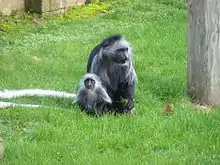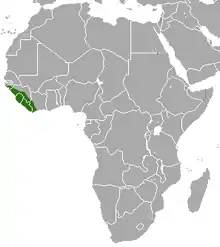King colobus
The king colobus (Colobus polykomos), also known as the western black-and-white colobus, is a species of Old World monkey, found in lowland and mountain rain forests in a region stretching from Senegal, through Guinea-Bissau, Guinea, Sierra Leone and Liberia to the Ivory Coast.[2] One of five members of the Genus Colobus which are the black-and-white colobuses. Among all African colobus monkey species, the King colobus (and the Western Red Colobus) is the westernmost species on the continent of Africa.[3] It eats mainly leaves, but also fruits and flowers. Though it is arboreal, it eats primarily on the ground. It lives in small groups consisting of 3 to 4 females and 1 to 3 males, plus their young. These groups maintain distance from one another through territorial calling.[4]
| King colobus[1] | |
|---|---|
 | |
| Scientific classification | |
| Kingdom: | Animalia |
| Phylum: | Chordata |
| Class: | Mammalia |
| Order: | Primates |
| Suborder: | Haplorhini |
| Infraorder: | Simiiformes |
| Family: | Cercopithecidae |
| Genus: | Colobus |
| Species: | C. polykomos |
| Binomial name | |
| Colobus polykomos (Zimmermann, 1780) | |
 | |
| King colobus range | |
Etymology
The word 'Colobus' comes from the Greek word for 'mutilated', as all Colobus monkeys only have a short stump where the thumb would be. The word 'poly' comes from the Greek word for 'many.' The word 'komos' comes from the Greek celebration of unrestrained singing. A possible subspecies known as C. p. dollmani can be found but is most likely a hybrid with C. vellerosus.[2]
Description
Body Size
The male king colobus grows to a head-and-body length of 670 mm (26 in), with a tail of between 630 and 900 mm (25 and 35 in). The female is slightly smaller. Males weigh an average of 9.90 kg and females weigh an average of 8.30 kg.[4]
Coloration
The body is black, the limbs and fingers are long and the tail is white. There is a fringe of silvery hair around the face as well as long white "epaulettes" on its shoulders.[5] The king colobus can be distinguished from other members of the Colobus genus by the placement of its white markings. The king colobus has white only on its whiskers, chest, and tail, and its tail is not covered by a tuft.[4]
Distribution and habitat
The king colobus monkey is found in lowland and montane tropical rainforests.[2] The region in which they inhabit is limited to a small range on the Ivory Coast up to Gambia.[4] They can also be found in Senegal, through Guinea-Bissau, Guinea, Sierra Leone and Liberia.[2] Much of the habitat of the “C. polykomos” has been destroyed by humans for farming and secondary forests have begun to fill in this area.[4] The forest habitats of the organism experiences significant dry seasons and two rainfall peaks. This area is dominated by leguminous trees.[4]
Behaviour and Biology
Diet
Diet consists mainly of arboreal leaves, but includes fruit and flowers depending on the season.[4] It can be found foraging on the ground[4]and typically stays within a foraging path of approximately 500 meters.[4]
Social structure
It lives in small groups of less than 4 females and 1 to 3 males.[4] Unlike males, females interact closely: males rarely interact and try to show dominance.[4]
Activity
The king colobus have an average home range of 22 hectares with some overlap between groups. Groups rarely encounter other groups of the same species but when they do, males engage in aggressive displays. Territorial calling is a common form of aggression but can also be a warning to the group of predators.[4]
Reproduction
The king colobus live in a unimale (polygynous) and multimale (polygynandrous) mating system. Some groups have shown year round births while others have shown births in relation to the dry seasons. The average gestation period is 175 days and the females produce 1 offspring every 20 months.[4] Both males and females reach sexual maturity at approximately 730 days or 2 years. Females provide the parental care by providing milk, grooming, protection and carry the newborns as they cannot walk immediately. .[4]
Lifespan
King Colobus have been shown to live approximately 23.5 years in captivity and possibly around 30 years in the wild.[4]
Status and Conservation
The king colobus has a moderate-sized range; it used to be a common and widespread species but numbers have declined over the last few decades. The main cause for the decline is hunting which is threatening and fragmenting populations. The 19th century exhibited hunting of the “C. polykomos” for its fur.[4] There is also a continuing decline in the quality and quantity of the forested habitat where it lives; it seems to be largely restricted to primary forest and gallery forest, although it sometimes visits secondary forest. The International Union for Conservation of Nature has rated its conservation status as being endangered.[2] Maintaining this species in captivity has mostly failed and focus has been on managing the habitats to prevent further degradation and habitat destruction that could harm the species.[4]
References
- Groves, C. P. (2005). Wilson, D. E.; Reeder, D. M. (eds.). Mammal Species of the World: A Taxonomic and Geographic Reference (3rd ed.). Baltimore: Johns Hopkins University Press. p. 168. ISBN 0-801-88221-4. OCLC 62265494.
- Gonedelé Bi, S., Koné, I., Matsuda Goodwin, R., Alonso, C., Hernansaiz, A. & Oates, J.F. (2020). "Colobus polykomos". IUCN Red List of Threatened Species. 2020: e.T5144A17944855. Retrieved 10 July 2020.CS1 maint: uses authors parameter (link)
- Minhós, Tania; Chikhi, Lounès; Sousa, Cláudia; Vicente, Luis M.; Ferreira da Silva, Maria; Heller, Rasmus; Casanova, Catarina; Bruford, Michael W. (February 2016). "Genetic consequences of human forest exploitation in two colobus monkeys in Guinea Bissau". Biological Conservation. 194: 194–208. doi:10.1016/j.biocon.2015.12.019. hdl:10362/89503.
- Landes, D. (2000). "Colobus polykomos". Animal Diversity Web. Retrieved 11 March 2013.
- Jonathan Kingdon (2015). The Kingdon Field Guide to African Mammals: Second Edition. Bloomsbury Publishing. p. 112. ISBN 978-1-4729-2531-2.
External links
| Wikispecies has information related to King Colobus. |
